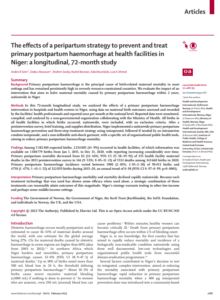
Background: Primary postpartum haemorrhage is the principal cause of birth-related maternal mortality in most settings and has remained persistently high in severely resource-constrained countries. We evaluate the impact of an intervention that aims to halve maternal mortality caused by primary postpartum haemorrhage within 2 years, nationwide in Niger.
Methods: In this 72-month longitudinal study, we analysed the effects of a primary postpartum haemorrhage intervention in hospitals and health centres in Niger, using data on maternal birth outcomes assessed and recorded by the facilities’ health professionals and reported once per month at the national level. Reported data were monitored, compiled, and analysed by a non-governmental organisation collaborating with the Ministry of Health. All births in all health facilities in which births occurred, nationwide, were included, with no exclusion criteria. After a preintervention survey, brief training, and supplies distribution, Niger implemented a nationwide primary postpartum haemorrhage prevention and three-step treatment strategy using misoprostol, followed if needed by an intrauterine condom tamponade, and a non-inflatable anti-shock garment, with a specific set of organisational public health tools, aiming to reduce primary postpartum haemorrhage mortality.
Findings: Among 5 382 488 expected births, 2 254 885 (41·9%) occurred in health facilities, of which information was available on 1 380 779 births from Jan 1, 2015, to Dec 31, 2020, with reporting increasing considerably over time. Primary postpartum mortality decreased from 82 (32·16%; 95% CI 25·58-39·92) of 255 health facility maternal deaths in the 2013 preintervention survey to 146 (9·53%; 8·05-11·21) of 1532 deaths among 343 668 births in 2020. Primary postpartum haemorrhage incidence varied between 1900 (2·10%; 2·01-2·20) of 90 453 births and 4758 (1·47%; 1·43-1·52) of 322 859 births during 2015-20, an annual trend of 0·98 (95% CI 0·97-0·99; p<0·0001).
Interpretation: Primary postpartum haemorrhage morbidity and mortality declined rapidly nationwide. Because each treatment technology that was used has shown some efficacy when used alone, a strategic combination of these treatments can reasonably attain outcomes of this magnitude. Niger’s strategy warrants testing in other low-income and perhaps some middle-income settings.